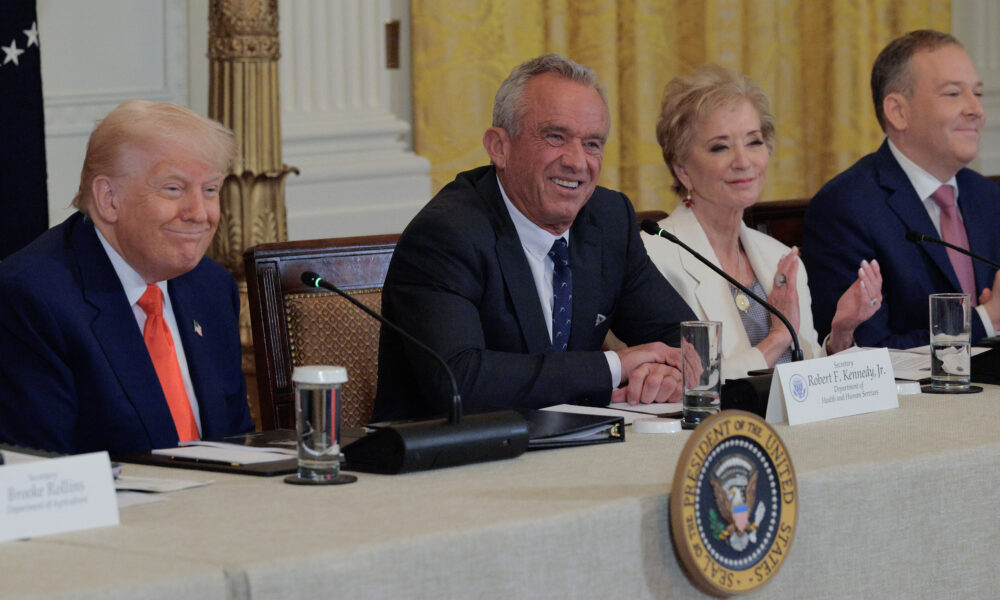Another month has gone by with multiple instances of the Trump administration using political interference to suppress science. By now, it’s a familiar—and infuriating—story. But here’s what’s new: we’re seeing an even more obvious effort from the Trump administration to co-opt science in its efforts to undermine scientific integrity.
Increasingly, we’re seeing political leaders using the language of science and scientific integrity as a front to stand behind, while simultaneously undermining real science—all aimed toward replacing scientific evidence with hand-picked misinformation meant to advance their political goals. If you’ve been following my monthly round-ups, you may have noticed this theme emerging in the larger context of all the Trump administration is doing to dismantle the federal scientific infrastructure.
Since my last summary, we’ve counted 66 potential attacks on scientists, their work, and science-based policies in the federal government. That means that, since Inauguration Day, 418 of the administration’s actions, decisions, or policies may have undermined science or the scientific process. That’s a pace and scale we’ve never seen before. These numbers include instances of co-opting science, too.
Like my other blog posts, this summary is a small snapshot of the bigger, chaotic, harmful picture; it is not a comprehensive analysis of all the possible ways science has been undermined. But all the same, I understand how seeing so many harmful instances in one place can be hard to read. If you came here to learn how to help UCS in our fight to protect federal science, I’ve included information and resources at the bottom of this page.
The administration targets scientific integrity
Last week, President Trump signed an executive order (EO) directly relevant to the role of science and SI policies in the federal government. As I explain in more detail here, SI policies in federal agencies have four main goals. They were created to (1) protect the scientific process from inappropriate influence, (2) to make federal research and evidence publicly accessible (without compromising people’s safety or data), (3) to let federal scientists share their results and studies freely, and (4) to use the best available science in decision and policy making.
In short, the EO directs federal agencies to roll back SI policies to what they were before President Trump left the White House after his first term, effectively weakening or eliminating federal agency policies.
It also requires agencies to replace SI policies with the Trump administration’s views—largely informed by Project 2025—of how the federal government should use science. The Trump administration attempts to conceal the impact of the EO by wrapping it in the disguise of things that the majority of Americans agree with and endorse.
There is a lot to unpack about this EO, but I want to highlight two of its proposed actions here and how they relate to other political interference we’ve observed from the Trump administration over the past few weeks. If you’re interested to learn more about the EO outside of this brief discussion, check out my explainer blog post on this EO, my colleague Kristie Ellickson’s blog post on the history of how the tobacco and fossil fuel industries created this strategy, and this new piece in BMJ on the new executive order that I co-wrote with UCS President Gretchen Goldman.
Independent science must be protected
Interestingly, many of the criteria for federal science named in the order, like “transparency,” “peer-review,” and “reproducibility,” are all components of the scientific method. The EO both insists on the importance of these principles–and orders federal agencies to weaken SI policies that encourage them. But a critical characteristic of scientific research and integrity is not named once in the new proposed guidance outlined in the EO: independence.
Keeping science independent means preserving the validity and integrity of the scientific method. It means allowing scientists and experts to design, conduct, and disseminate their work without any type of interference, political or otherwise. Independence allows scientific results to stand on their own and not be misinterpreted, misconstrued, altered, or buried if they’re found to be inconvenient to a stakeholder, organization, or political official.
Independence also allows tried-and-true scientific peer-review processes to facilitate rigorous, well-informed research. These processes make space for scientists to share potential limitations of their methodology and acknowledge their study is not the be-all-end-all, but rather one piece in the puzzle of the collective knowledge on a topic. This independence is absolutely critical in ensuring that policy is informed by the best available science.
Without that independence, scientific analysis is vulnerable to political interference. When political appointees request a “redo” of a robust and independently-confirmed analysis because they fear the results could be “used against” the White House’s justification of its policy decisions, that is political interference, and a blatant violation of scientific independence and integrity.
Protecting independent science is a matter of public health, environmental safety, and national security.
Who decides?
The EO also directs that, rather than career staffers with expertise in their agencies’ content areas, scientific integrity policies and violations should be enforced solely by political appointees. The same EO that was framed as an attempt to remove politics from the scientific process also gives political officials oversight over scientific integrity. (If you’re also confused by this…that’s the goal.)
This EO came shortly before the release of an Office of Personnel Management (OPM) memo that outlines how federal agencies should enforce President Trump’s directive regarding the federal hiring process. On page nine of this new guidance, OPM outlines four short-answer questions that all federal job applicants must answer as part of their application, one of which asks how applicants will “help advance the President’s Executive Orders and policy priorities in [their] role.”
Although the House Oversight Committee has already called attention to, and initiated investigations on, what Acting Ranking Member Stephen F. Lynch is calling a “blatant loyalty test,” this is a very alarming development. Under President Trump’s new EO on federal science, any political officials who would be overseeing scientific integrity policies and enforcement would also have to have passed this “loyalty test.”
If this were true, particularly in the broader context of the Trump administration’s anti-science actions and decisions, it spells trouble for the concept of independence in federal science. We’ll be following this development very closely.
“MAHA” makes a hazardous argument
As I said earlier, this EO is not the first instance of the Trump administration trying to position itself rhetorically as pro-science, while gutting the federal scientific enterprise and ignoring the best available science on issues like chemical safety, vaccination, and climate change. As you may recall from my last summary blog post, the Department of Health and Human Services (HHS) recently released a methodologically questionable (at best) report that attempts to sow doubt in the best available science on gender-affirming care.
While the report uses scientific terminology and was released by the U.S.’s leading public health agency–giving the impression of scientific authority and knowledge–there were a lot of methodological red flags about the report. A similar story could be told regarding HHS’ absurdly-titled “Make American Healthy Again” (MAHA) report.
The MAHA report covers a lot more topical ground within its pages, covering children’s diets and exposures to toxic chemicals as well as questioning the safety of vaccines, stimulants, and antidepressants. Advocating for children’s health and safety is most definitely a good thing, but the way in which the report was conducted leaves a lot of doubt in whether it was completed with the best scientific practices.
Like the gender-affirming care report, experts have called attention to the ways the report contrasts with the best available science in many of its conclusions. In addition, most if not all the authors of the report (who are members of the MAHA commission), have documented conflicts of interest and/or a history of anti-science actions on the record, casting further doubt on the scientific merits of the report. The majority of the commission’s members do not have scientific or technical expertise in the research areas covered in the report.
Another glaring red flag about this report is the fact that, upon release, experts discovered that there were multiple citations included in the report that don’t exist, and other studies whose results were misconstrued to support the commission’s conclusions. After HHS claimed the fake studies were included in error, 18 citations were edited or changed to include new citations–many of which still misinterpreted scientific results. Even some of the experts whose work is cited in the MAHA report say that the report doesn’t accurately reflect their research.
Worse yet, technology and artificial intelligence (AI) experts point to evidence suggesting AI was used in the development of the report, with journalists annotating specific examples to emphasize this point. AI programs are created, maintained, and programmed by people. Just like any human being, AI -generated text can be subject to bias and manipulation. This can lead AI programs, even without any additional probing or programming by individual users, to provide skewed responses that align with its user’s intentions, rather than objective information. AI-generated text is simply unreliable as scientific information, and it is unsettling to think it’s being used to justify decisions about such serious matters. People will be put in real danger if the government misleads them or makes bad policies premised on misinformation.
What’s more worrisome is that the use of AI could result in the inclusion of the fabricated sources. This puts the integrity and validity of the entire report into question. Ironically, the MAHA commission endorsed the use of AI as a tool to “better evaluate the environmental exposures of chronic disease in children.”
These discoveries would be alarming in isolation, but again I ask you to view these actions within the broader context of the Trump administration’s actions. There is now a documented thread of politicized actions and decisions from HHS on topics covered in this very report, including vaccine safety and efficacy and neurodevelopmental disorders. HHS Secretary Robert F. Kennedy Jr. and his top aides came into office with pre-existing and scientifically-indefensible beliefs on these topics and are using shoddy scientific practices to try and reshape national policy around these myths.
After gutting the ability for scientific experts to independently conduct research on these topics, HHS has allocated resources to examine conspiracy theories that have been famously debunked and to hire people with conflicts of interest on the record to conduct that research. It’s unsurprising in this context that the MAHA report supports the politicized conclusions that members of the administration have advocated for since inauguration.
We can defend science, together
It takes a village, as they say, to defend science in the federal government. If you’re interested in getting more involved in this fight, here are some resources:
- If Congress were to pass the SI Act, it would codify protections for federal scientists and their work into law. In short, it would help prevent political interference in scientific research. You can contact your members of Congress using this easy link – ask them to cosponsor the SI Act!
- Do you have a strong interest in science-based policy? Are you interested in using your voice to advocate for scientific integrity in the federal government? Sign up to become a Scientific Integrity Champion using this link!
- Stay up to date on our Save Science Save Lives campaign, and attend some of our sponsored events to learn more about how to protect science in real time.

